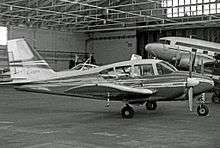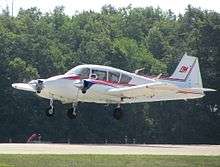Piper PA-23
| PA-23 Apache/Aztec | |
|---|---|
 | |
| PA-23 Aztec in Toronto, Ontario | |
| Role | Twin-engined light piston utility |
| Manufacturer | Piper Aircraft |
| First flight | 2 March 1952 |
| Introduction | 1954 |
| Produced | 1952–1981 |
| Number built | 6,976 |
The Piper PA-23, named Apache and later Aztec, is a four-to-six-seat twin-engined light aircraft aimed at the general aviation market. The United States Navy and military forces in other countries also used it in small numbers. Originally designed in the 1950s by the Stinson Aircraft Company, Piper Aircraft manufactured the Apache and a more powerful version, the Aztec, in the United States from the 1950s to the 1980s.
Design and development
The PA-23 was the first twin-engined Piper aircraft, and was developed from a proposed "Twin Stinson" design, inherited when Piper bought the Stinson Division of the Consolidated Vultee Aircraft Corporation.[1] The prototype PA-23 was a four-seat low-wing all-metal monoplane with a twin tail, powered by two 125 hp Lycoming O-290-D piston engines;[1] it first flew on 2 March 1952.[2] The aircraft performed badly and it was redesigned with a single vertical stabilizer and an all-metal rear fuselage and more powerful 150 hp Lycoming O-320-A engines.[1]
Apache
Two new prototypes of the redesigned aircraft, now named Apache, were built in 1953[1] and entered production in 1954; 1,231 were built. In 1958 the Apache 160 was produced by upgrading the engines to 160 hp (119 kW); 816 were built. The Apache 160 was superseded in 1962 by the Aztec-derived Apache 235. With a 1962 price of $45,000, the Apache 235 featured the Aztec's 235 hp (175 kW) engines and swept tail surfaces (119 built).[3]
Aztec
The same year, Piper produced an upgraded version with 250 hp (186 kW) Lycoming O-540 engines and a swept vertical tail as the PA-23-250, and named it Aztec.[1] The first models came in a five-seat configuration in 1959. In 1961 a longer nosed variant, the Aztec B, entered production.[1] Later Aztecs were equipped with IO-540 fuel-injected engines and six-seat capacity, and remained in production until 1982. There were also turbocharged versions of the later models, which could fly at higher altitude.
The United States Navy acquired 20 Aztecs, designating them UO-1, which changed to U-11A when unified designations were adopted in 1962.
In 1974, Piper produced a single experimental PA-41P Pressurized Aztec concept. This concept was short-lived, however, as the aspects of the Aztec that made it so popular for its spacious interior and ability to haul large loads did not lend themselves well to supporting the sealed pressure vessel required for a pressurized aircraft. The project was scrapped, and the one pressurized Aztec produced, N9941P, was donated to Mississippi State University, where it was used for testing purposes. In 2000, N9941P was donated to the Piper Aviation Museum in Lock Haven, Pennsylvania, on condition that it never be flown again. It is now there on display.
Variants
Apache




- PA-23 Twin-Stinson
- Original designation of the Piper PA-23 Apache.
- PA-23 Apache
- Initial production version, 2047 built (including the Apache E, G and H).
- PA-23-150 Apache B
- 1955 variant with minor changes.[1]
- PA-23-150 Apache C
- 1956 variant with minor changes.[1]
- PA-23-150 Apache D
- 1957 variant with minor changes.[1]
- PA-23-160 Apache E
- PA-23 powered by two 160 hp O-320-B engines.
- PA-23-160 Apache G
- PA-23 with longer internal cabin and extra window.
- PA-23-160 Apache H
- Apache G with 0-320-B2B engines and minor changes.
- PA-23-235 Apache 235
- Apache with five seats and 235 hp O-540 engines, 118 built.
- PA-23-250 Aztec
- Apache G with modified rear fuselage, new fin and rudder and 250hp Lycoming O-540-A1D engines, 4811 built (including sub-variants)
- Seguin Geronimo
- Apache with a series of modifications to the engines, nose and tail.[4]
Aztec

- PA-23-250 Aztec B
- 1962-1964. Aztec with longer nose for a baggage compartment; six seats, new instrument panel and changes to systems.
- PA-23-250 Aztec C and Aztec C Turbo
- 1964-1968. Aztec B with either IO-540-C4B5 engines or turbocharged TIO-540-C4B5 as an option, also modified engine nacelles and modified landing gear.
- PA-23-250 Aztec D and Aztec D Turbo
- 1969-1970. Aztec C with revised instrument panel and controls.
- PA-23-250 Aztec E and Aztec E Turbo
- 1971-1975. Aztec D with longer pointed nose and a single piece windshield.
- PA-23-250 Aztec F and Aztec F Turbo
- 1976-1981. Aztec E with improved systems and cambered wingtips and tailplane tip extensions.
- U-11A
- United States Navy designation formerly UO-1.
- UO-1
- United States Navy designation for PA-23-250 Aztec with additional equipment; 20 delivered, later re-designated U-11A.
- PA-41P Pressurized Aztec
- Pressurized Aztec concept, one built.
Operators
Military operators











- Spanish Air Force
- Escuadrón 912
- Escuadrilla de Enlace 905
- Paraguayan Air Force
- Grupo Aéreo de Transporte Especial/GATE
Specifications (PA-23-250F, normally aspirated)
Data from Jane's All The World's Aircraft 1976–77[5]
General characteristics
- Crew: one
- Capacity: five passengers
- Payload: 1,600 lb (725 kg) cargo
- Length: 31 ft 2¾ in (9.52 m)
- Wingspan: 37 ft 2½ in (11.34 m)
- Height: 10 ft 4 in (3.15 m)
- Wing area: 207.6 ft² (19.28 m²)
- Airfoil: USA 35-B (modified)
- Aspect ratio: 6.8:1
- Empty weight: 3,180 lb (1,442 kg)
- Max. takeoff weight: 5,200 lb (2,360 kg)
- Powerplant: 2 × Lycoming IO-540-C4B5 normally aspirated air-cooled flat-six piston engines, 250 hp (187 kW) each
- Propellers: two bladed Hartzell HC-E2YK-2RB constant speed propeller
Performance
- Never exceed speed: 277 mph (240 knots, 446 km/h)
- Maximum speed: 215 mph (187 knots, 346 km/h)
- Cruise speed: 172 mph (150 knots, 278 km/h) at 10,200 ft (3,110 m) (long-range cruise)
- Stall speed: 68 mph (59 knots, 109 km/h) (flaps down)
- Range: 1,519 miles (1,320 nmi, 2,445 km) at long-range cruise
- Service ceiling: 18,950 ft (5,775 m) (absolute ceiling)
- Rate of climb: 1,400 ft/min (7.1 m/s)
Accidents and incidents
- On 21 March 1964, a Piper PA-23-160 Apache (G-ASHC) crashed on its approach to Aintree racecourse, near Liverpool, killing all 5 on board. The flight had taken off from Luton Airport and included broadcaster Nancy Spain, who was covering the Grand National, and her friend Joan Werner Laurie, who was learning to fly. The CAA accident report stated that passenger interference could not be ruled out as a cause of the accident.[6]
- On 18 April 1974, Aztec G-AYDE was involved in a ground collision with BAC One-Eleven G-AXMJ at London Luton Airport after the pilot of the Aztec entered the active runway without clearance. He was killed and his passenger was injured. All 91 people on board the One-Eleven successfully evacuated after the takeoff was aborted.
- On 29 November 1975, retired Formula One racing driver and Embassy Hill team owner Graham Hill was piloting a Piper PA-23-250 Turbo Aztec D, marked as N6645Y,[lower-alpha 1] from Circuit Paul Ricard, France, to London, United Kingdom.[7] His passengers were Embassy Hill race driver Tony Brise, team manager Ray Brimble, designer Andy Smallman and mechanics Terry Richards and Tony Alcock. While on approach to land at Elstree Airfield, Hertfordshire, shortly before 10 pm, in thick fog the aircraft hit trees on a golf course at Arkley, Hertfordshire. The ensuing crash and explosion killed everyone on board.[8][9]
- On 15 April 1978, Hollywood stunt flyer Frank Tallman was ferrying a Piper Aztec from Santa Monica Airport, California, to Phoenix, Arizona under visual flight rules when he continued the flight into deteriorating weather, a lowering ceiling and rain. He struck the side of Santiago Peak in the Santa Ana Mountains near Trabuco Canyon at cruise altitude, dying in the ensuing crash.[10][11]
See also
Aircraft of comparable role, configuration and era
- Beagle B.206
- Beechcraft Baron
- Cessna 310
- Helio Twin Courier
- Let L-200 Morava
- Partenavia P.68
- Piper PA-34 Seneca
References
Notes
- ↑ Although marked with a United States registration and carrying the appropriate registration documentation the aircraft had been cancelled from the American register in 1974; the new owners had not re-registered the aircraft so was unregistered and stateless at the time of the accident
- 1 2 3 4 5 6 7 8 9 Peperell 1987, pp. 91-104
- ↑ Flying Magazine: 30. August 1952. Missing or empty
|title=(help) - ↑ Flying Magazine: 11. November 1962. Missing or empty
|title=(help) - ↑ Bill Cox (December 1, 2004). "Geronimo! For many light-twin owners, Piper's Apache is about as good as it gets". Plane & Pilot. Madavor Media. Retrieved 13 January 2017.
- ↑ Taylor 1976, pp. 348–349.
- ↑ Aviation Safety Network http://aviation-safety.net/wikibase/wiki.php?id=66552
- ↑ "Aircraft Accident Report 14/76" (PDF). Accidents Investigation Board. 29 September 1976. Retrieved 25 November 2011.
- ↑ BBC, This day in history-- 1975: Graham Hill killed in air crash.
- ↑ Graham Hill, 46, Retired Racer, In Fatal Crash Piloting His Plane. UPI News Service. December 1, 1975 (Monday) New York Times archive
- ↑ "NTSB Identification: LAX78FA043". National Transportation Safety Board. Retrieved July 27, 2017.
- ↑ "The Reaper Catches Up . . . In Trabuco Canyon, California April 15, 1978". Check-Six.com. Retrieved July 8, 2016.
Bibliography
- Peperell, Roger W; Smith, Colin M (1987). Piper Aircraft and their Forerunners. Tonbridge, Kent, England: Air-Britain. ISBN 0-85130-149-5.
- Taylor, John W. R. (1976). Jane's All The World's Aircraft 1976–77. London: Jane's Yearbooks. ISBN 0-354-00538-3.
External links
|
|
|